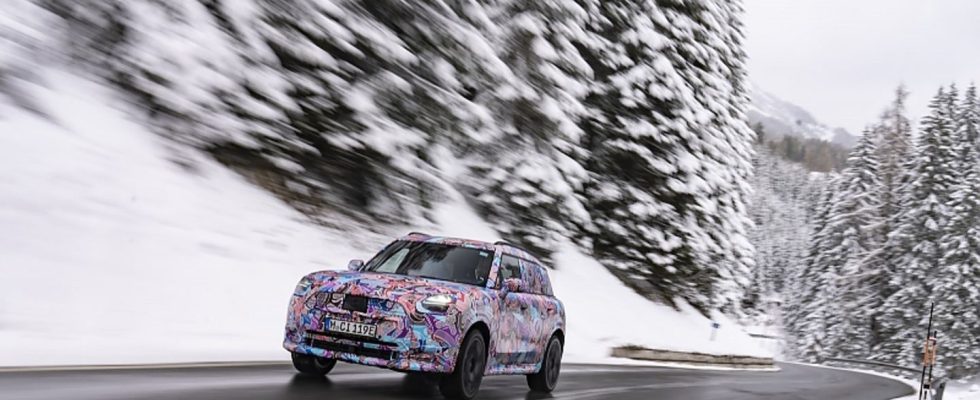Technology: On the road in the Mini Countryman SE prototype
The big Brother
Mini Countryman SE All4 prototype
© press-inform – the press office
The new Mini Countryman is already scratching the tires in the stables. After the world premiere at the Munich IAA in autumn, the upcoming Countryman should also attract new customers as an electric version.
Contrary to what many had expected, Mini with its new generation, which will be rolling out to customers at the beginning of next year, will not yet be completely electric. Not only will the Mini Cooper still be available with a combustion engine. The same applies to the Mini Countryman produced in Leipzig, which follows in the footsteps of the BMW iX1 as an electric variant. While the little brother, the Mini Aceman, is somewhat surprisingly only available as a front-wheel drive, customers with the 4.43 meter long Mini Countryman have the choice of driving into their own garage with front (E) or all-wheel drive (SE All4). There will initially be two power levels for the electric Countryman with 140 kW / 190 PS and 230 kW / 313 PS. At least at the market launch, there will be a 64.7 kWh battery alone, which should achieve a range of up to 450 kilometers.
Technically, the Mini Countryman is closely related to the BMW X1 / iX1; but you can’t see it either inside or outside. This makes it the very first Mini in history to be produced in Germany. Production in Leipzig will begin in November of this year, shortly after the official world premiere at the IAA in mid-September – the market launch will be just a little later, at the turn of the year. The design is typically Mini, the proportions are typically Countryman. While the current generation has already improved significantly, the coming Countryman is growing noticeably again. The length has increased by 13 centimeters to 4.43 meters, which is suitable for the middle class, which is particularly noticeable in the interior with more seating comfort in the second row. With a height of 1.61 meters, it is also six centimeters higher than before – this also noticeably increases the level of comfort. As before, customers can choose whether they want to drive their crossover with a closed roof or let the sun shine into the car and heart via an electrically operated panoramic roof.
The cockpit is dominated by a large central circular instrument on which all important information is displayed. The most important details are only projected into the driver’s field of vision via a head-up display for an extra charge; unfortunately only on an extendable plastic disc behind the steering wheel, which makes the whole thing appear to be of little value in this segment. In view of the ever-larger displays for the driver and front passenger in the mid-2020s, this might be a retro-loving step by mini designers. It is also surprising that at least the electric version will have different driving programs that can be operated via a toggle switch in the center console, but adjustable dampers are missing. These are reserved for the around 250 kilogram lighter versions with combustion engines. A flaw that you can definitely get over with a mid-range SUV. The problem, however, is that both competitors and their own combustion engine brothers offer this.
On the road, the prototype of the Mini Countryman makes a well-balanced impression. The toughness of past years and generations is over and in view of the up to 230 kW / 313 hp, the electric Mini Countryman SE All4 does not have to artificially become a sports cannon here – the drive package already ensures that, with identical power already convincing with the BMW iX1. An even stronger John Cooper Works should follow anyway.
The BMW iX1 x30 currently consumes around 20 kWh per 100 kilometers. However, the British Bavarians should make improvements when it comes to fast charging, because the identical BMW iX1 currently offers a maximum charge of 130 kW. From 10 to 80 percent it takes around half an hour. It remains to be hoped that the new Mini Countryman E / SE will add at least 170 kilowatts. After all, the competition is leading the way. However, it is doubtful whether the Mini customers can make friends with doing without noble leather seats inside. Especially the better equipped versions of the Mini and Mini Countryman have been on the road with heated leather seats for many years, which will be deleted in the future. The coverings of the new models are exclusively made of plastic. It is also over with the ever so popular chrome and decorative elements in the exterior / interior. The surfaces of the dashboard, steering wheel, headliner, floor and floor mats are made of recycled polyester made from PET bottles and carpet scraps.

